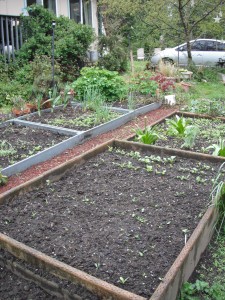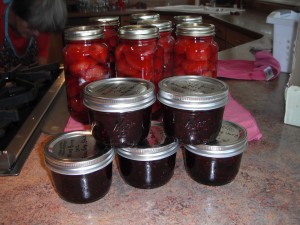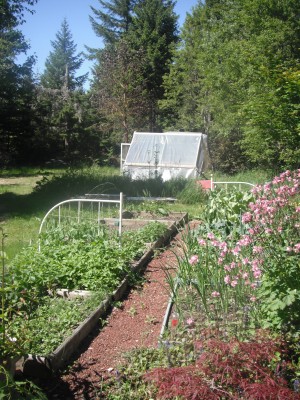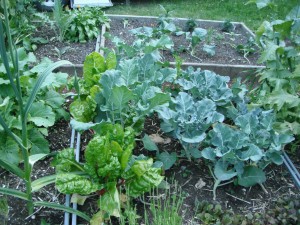Archive for c) Permaculture & Vegetable Gardens
Permaculture, human endeavor with an environmental ethic
Permaculture is short for permanent agriculture. It is the conscious design and maintenance of food-producing ecosystems which have the diversity and resilience of natural ecosystems. It has grown to include the sustainable production of energy, shelter, and other materials.
The philosophy behind permaculture is one of working with, rather than against nature; creating a harmonious landscape ecosystem for people and wildlife — Permaculture is a creative design process, based on an environmental ethic, that encourages us to study, observe, & mimic the patterns and relationships we find in nature.
By adopting the ethics and applying these principles, we can make the transition from being dependent consumers to producing some of our own healthy food and materials. We can also relearn traditional skills, such as food preservation & general self-suffiency that our ancestors relied upon for survival. These skills and community-supported permaculture programs may help us to prepare for an uncertain future as populations increase and food & other resources become scarcer on our finite planet.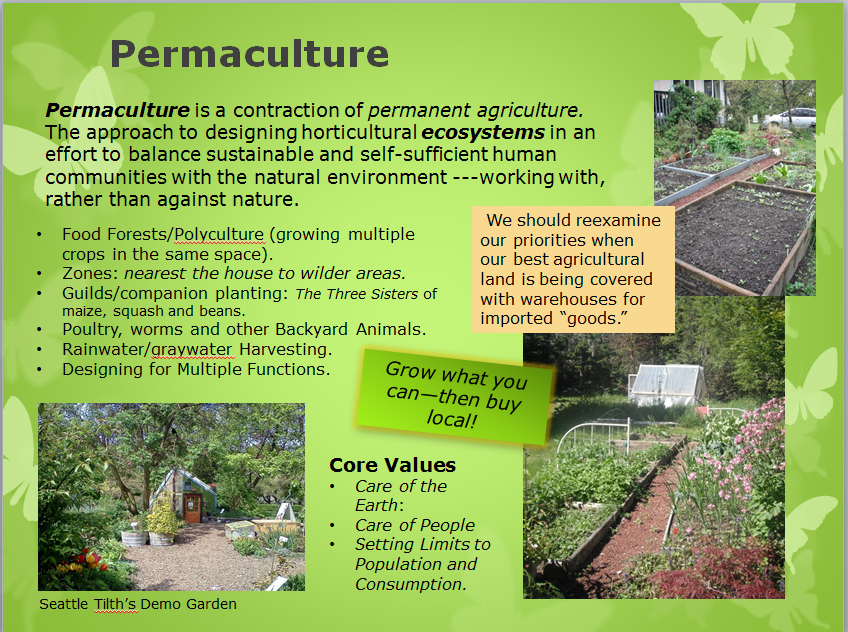
Central to permaculture are the three ethics: care for the earth, care for people, and fair share. They form the foundation for permaculture design and are also found in most traditional societies. Following are the 12 principles of permaculture as described by David Holmgren, with some of my own editorial comments:
1. Observe and Interact – Take the time to engage with nature. We are often focused on work and the task at hand such that we forget to appreciate what surrounds us…take notice of the flowers & the birds & the beauty that surrounds you.
2. Catch and Store Energy –Collect resources when they are abundant and use them in times of need: Catch water with rain barrels, compost to store nutrients for plants, & harvest & preserve food for future use.
3. Obtain a yield – Ensure that you are getting truly useful rewards as a result of the work you are doing…emotional and psychological rewards, as well as staple foods and sweet fruit– nature’s candy!
4. Apply Self-Regulation and Accept Feedback –discourage inappropriate activity to ensure that systems can continue to function well…avoid chemicals and other harmful inputs to the ecology of your garden. Take notice to see what works…and what doesn’t.
5. Use and Value Renewable Resources and Services –Make the best use of nature’s abundance to reduce our consumptive behavior and dependence on non-renewable resources. I use the cheapest local sources for soils, natural fertilizers, mulches and other materials; reusing & repurposing what I can.
6. Produce No Waste –By valuing and making use of all the resources that are available to us, nothing goes to waste…food scraps can go to pigs, chickens, or worms or can just be composted.
7. Design From Patterns to Details –By stepping back, we can observe patterns in nature. These can form the backbone of our designs, with the details filled in as we go…getting inspiration from nature!
8. Integrate Rather Than Segregate – By putting the right things in the right place, relationships develop between those things and they work together to support each other… know whether plants need sun or shade, wet or fairly dry, or benefit from companion plants.
9. Use Small and Slow Solutions –Small and slow systems are easier to maintain than big ones, making better use of local resources and produce more sustainable outcomes…Focus on small sections of your garden at a time, improving soil and building populations of beneficial organisms.
10. Use and Value Diversity – Diversity reduces vulnerability to a variety of threats and takes advantage of the unique nature of the environment in which it resides. By growing several crops you avoid “putting all your eggs in one basket.” You will have some failures, but hopefully your successes outweigh the cost of a failure. In nature, some trees will produce heavily one year and sparsely the next as a strategy to control the population of frugivores or seed-eaters. By growing a variety of species you are more likely to have a healthy ecosystem and a more stable food source.
11. Use Edges and Value the Marginal –The interface between things is where the most interesting events take place. These are often the most valuable, diverse and productive elements in the system. Edges of forests are the most diverse wildlife habitat and ideal growing conditions for many shrubs.
12. Creatively Use and Respond to Change –We can have a positive impact on inevitable change by carefully observing and then intervening at the right time. Use IPM, Integrated Pest Management techniques to monitor and control pest populations. Remember that landscapes are dynamic, constantly changing through the seasons, and through the years…
A Permaculture Garden can be divided into zones as follows:
Zone 0–The house, or home center in a permaculture design creates a harmonious, sustainable environment in which to live, work & play. It uses energy and water conservatively and incorporates sustainable energy systems such as wind, solar, or geothermal power.
Zone 1–The zone nearest to the house is for those elements in the system that require frequent attention. It may include a kitchen garden with raised beds for growing salad crops, vegetable & herb plants, strawberries, or other berries, propagation areas (greenhouse and cold frames), a chicken coop, and/or a worm compost bin for kitchen waste.
Zone 2 –Contains perennial plants that require less frequent maintenance. This may include orchards, berry bushes, squashes etc. beehives, larger scale composting bins, and so on.
Zone 3–The area where field crops are grown or livestock is pastured, both for domestic use and for trade purposes. After establishment, care and maintenance required, such as watering or weed control, are fairly minimal (maybe once a week). Livestock may need to be visited more often.
Zone 4–A semi-wild area. This zone is mainly used for forage and collecting wild food as well as production of timber for construction or firewood.
Zone 5–A wilderness area. There is no human intervention in zone 5 apart from the observation of natural ecosystems and cycles. Through this zone we build up a natural reserve of bacteria, molds and insects that can aid the zones above it. Eradication of invasive species may be needed at times.
One of my family’s favorite sitcoms is the 1970’s British TV show: “The Good Life” or“Good Neighbors.” In the show, Tom Good quits his job and he and his wife, Barbara, adopt a self-sufficient lifestyle in their suburban neighborhood to the horror of their good friends and neighbors. They grow fruits & vegetables in their front and back gardens. They raise chickens, pigs, and a goat. They even generate their own electricity, using methane from animal waste and attempt to make their own clothes. They sell or barter surplus crops for essentials they cannot make themselves. Although this lifestyle is probably not really feasible on a small suburban lot (but it makes for a funny sitcom!), and is difficult for those that have more property, we can try to adopt some of these goals and ideas, even though we can’t go all the way and quit our wage-earning jobs!
There are many local community groups that hold workshops on Permaculture. A quick internet search may find one near you!
Propagating Plants from Kitchen Scraps
Throughout most of human history, food was collected of grown within just a few miles of where people lived. Today, most Americans depend on food imported from far away for much of their diet.
We go to the grocery store and buy bananas from Ecuador, grapes from Chile and strawberries from Mexico. But it can be fun and educational to grow your own. You can even use kitchen scraps to grow a new plant—some for food, others just as an interesting houseplant.
- Tubers: Have you ever had potatoes begin to sprout in your pantry? I often plant them out in my garden. In our area, it is best to grow potatoes in a container or raised bed with new soil in order to prevent infestations from wireworms. You can start harvesting new potatoes when plants are big and blooming. Commercial potatoes are often treated to delay sprouting, so only plant those that have started to grow on their own. Planted Jerusalem Artichokes will multiply and grow into pretty sunflowers.
- Bulbs: Just recently I rescued some green onions from the compost pile. They were a little limp from the fridge, so I stuck them in a glass of water to hydrate them before I planted them out. I often plant extra garlic cloves into my garden beds. They grow quite nicely, but need to be marked because they are hard to find when dormant
- Rhizomes: Ginger and turmeric are tropical plants that can be grown inside to make an attractive houseplant.
- Cuttings: Many people put basil and other herbs in a glass of water to keep them fresh longer. Some herbs will grow roots and can be planted. To prolong harvesting, pinch off flowers. You can also regrow many plants from their top or crown. For pineapple, cut the top a quarter-inch or so below its base into the fruit and plant it in a sandy soil. The tops of carrots, beets, turnips and celeriac can similarly be planted to grow greens. For celery, cut most of the tops away and put the bottom in a dish of water until the leaves turn green and grow; then plant in soil.
- Seeds: You can grow houseplants from avocado, citrus, mango, and raw coffee bean seeds; but don’t expect to be harvesting anytime soon. They take many years to flower and fruit. I get kiwi, melon, squash and tomatoes coming up in my compost all the time, but store-bought varieties may require a warmer climate, or, due to cross pollination, the resulting fruit may be surprisingly different. You can try planting nuts, but I always have trouble with squirrels digging them up before they sprout. You can also try planting a bag of mixed dried beans in May. You can even plant birdseed, but usually the rodents and jays do that for you, especially the sunflowers! You could try planting spice seeds: anise, caraway, coriander, cumin, dill, fenugreek, mustard, poppy and sesame. Some, however, such as Fennel are considered noxious weeds in Washington. Fresh seed is best.
In the 17th century the Dutch East India Company brutally seized control and protected their monopoly of nutmeg production by executing natives and smugglers. To prevent the availability of fertile seeds they drenched the nutmegs in lime before shipping them out to be sold—So before you throw out or compost living plant material, decide whether it still has value. Perhaps you can regrow it!
What can I plant, when?
A couple of my friends have been asking what they should be planting and when…I am sure they are not alone in wanting garden scheduling advice.
An easy way to start is to use the following guide to divide up your seed packets according to planting times and whether they will be direct sown or grown as transplants. Although using a calendar is the easiest method to decide when to plant, soil temperature is actually a better guide to determine the best planting time.
Early Spring: (soil temperature 40-45° F) Plants that prefer colder temperatures can be planted in early March, (maybe even late February). Peas do not do well in hot weather so it is important to get them planted as early as possible. Radishes, lettuce, and spinach can be sown in successive plantings to extend harvest times until the weather gets too warm. They can be sown again in late summer or fall. Perennials such as asparagus, rhubarb, and strawberries can be planted as soon as they are available in nurseries.
Early Transplants: Some plants are better sown indoors and moved out to the garden later for better success and to extend the growing season for those crops that benefit from a longer period of warmth. Most can be started in early to mid-March, but artichoke is better sown earlier in the year. Cole crops such as broccoli, cauliflower, cabbage, kale, kohlrabi, and Brussels sprouts, prefer cooler temperatures and are best started in a cool greenhouse or a cold frame. Some herbs, such as parsley, can also be started early. I start my tomatoes and peppers in my warm house and transfer them to my greenhouse once they have germinated. If kept in the house, make sure they get plenty of light!
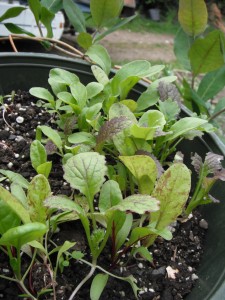
I like to grow salad greens or “Mesclun” mixes in a pot. It is easy to snip a few leaves to add to a sandwich!
If you haven’t started any transplants, you can buy starts at a nursery. The advantage of buying seeds and growing your own is that you can grow different varieties—I especially like seed mixes: my favorites include a hot pepper mix, a broccoli mix, and a lettuce or “mesclun, “(salad greens) mix. The disadvantage is that you end up with more plants than you can use. I often give extras to friends. You may even be able to plan with a friend and decide to grow certain plants to share with each other!
Mid-Spring: (soil temperature 45-55° F) Early April is a good time to sow many root crops such as carrots, beets, turnips and parsnips. You can also direct-sow the cole crops. Plant seed potatoes in a raised bed with new soil to avoid wireworm infestation. Onion starts should also be available at feed stores and nurseries.
Late Transplants: I like to give my cucumbers, pumpkins and squashes (including zucchini) a head start by starting them in mid-April. Basil can be sown at this time too.
The “average last killing frost” for the Puget Sound region is between April 1st – 15th. This is when it is considered safe to plant most transplants outside. But you may want to wait until the weather is warmer for your tomatoes, peppers and basil.
Late Spring: (soil temperature > 60° F) Corn, beans, gourds, and sunflowers need warm temperatures to germinate. A soil thermometer can help you to decide whether you can plant earlier than mid-May. If you didn’t start squashes earlier, you can also direct-sow them at this time.
For a more comprehensive guide, Seattle Tilth’s “The Maritime Northwest Garden Guide,” tells you month by month what can be planted outside, in a cold frame or inside, including flowers and herbs!
(This article was first published in the Peninsula Gateway on April 14, 2010)
Is home food preservation a lost art?
Autumn is harvest time. If you are like most people you have had some successes and some failures.
Some fruits and vegetables such as apples, winter squashes, cabbages, potatoes, and many root crops will store well without any preparation; as long as only healthy, intact, and unblemished produce is stored. These foods were traditionally stored in a root cellar dug into a hillside. Some root crops can just be left in the ground with extra mulch to prevent freezing. A proper root cellar needs darkness, cool temperatures (32-40° F), adequate ventilation, and high humidity, with no dripping condensation. Some older houses even have built in cupboards that have ventilation to the outside for storing produce.
Drying is perhaps the oldest form of food preservation; fish, meat, fruits, vegetables, and herbs have been dried in the sun for thousands of years. The traditional method is just to lay the food out on drying screens. Daytime temperatures, however, should be 85-100°F or more, which is unlikely in our climate—except with specially designed solar dehydrators. Homemade or commercial electric dehydrators give you much more control (especially in excluding insects and other pests). Oven-drying is only possible if your oven can be set at lower temperatures (130-150° F). Smoking is a better option for meats and fish, but requires a specially built barbecue or smokehouse. Curing, the dehydration of food using salts, is usually done prior to smoking.
Freezing was used in colder climates. Modern freezers make this the easiest way to preserve your food. It’s best to look up the best method for each crop. Fruit can be frozen with or without sugar or syrup. Berries can be frozen on trays to keep them separate and subsequently repackaged. Most vegetables need to be blanched first. Blanching involves dipping them in boiling water for a few minutes; this process slows enzyme action and preserves flavor, texture and nutritive value. I’ve found that frozen vegetables that were not blanched end up tasting bitter. Tomatoes, peppers and onions do not need to be blanched.
Fermentation uses microorganisms to convert starches and sugars to alcohol; barley into beer, fruits into wine, and cabbage into sauerkraut or kimchi. Wines, beers or ciders that have transformed into vinegar can then used to make pickles. Pickling involves soaking a food in acid (usually vinegar) to chemically transform it. Spices are added to many pickling recipes to make chutneys, relishes, and other sauces.
Early cultures stored fruit in honey. Although sugar had been known to Europeans since the time of the crusades, due to taxation and other trade barriers it was not widely available to common people until the end of the 19th century. With sugar, you can preserve fruits by making jams and jellies. For the best results, follow an appropriate recipe in a box of pectin.
Canning is a process of heating foods in jars or cans to destroy microorganisms and inactivate enzymes, as the jars cool they create a vacuum seal that prevents recontamination. This can be done with a large kettle or a pressure cooker. Canning fruits, such as peaches and pears (and tomatoes), is safe and rewarding. I have even made my own apple pie filling! Low-acid foods such as meat or vegetables (excluding pickles) need to be processed with a steam pressure canner to prevent against botulism poisoning.
Keep growing to eat healthy! Starts of cool-season vegetables can still be planted. — Sprouts can be grown year-round in your kitchen!
(This article was first published in the Peninsula Gateway on September 29, 2010)
Food Forests for the Future
Being an environmentalist and a native plant horticulturist/botanist, I encourage the planting of native plants to help restore and preserve the natural ecology of our beautiful Pacific Northwest. However, we must also balance the needs of people with the needs of wildlife. Food is a basic need of both. That is why I often recommend planting cultivated varieties of food plants as well as native species.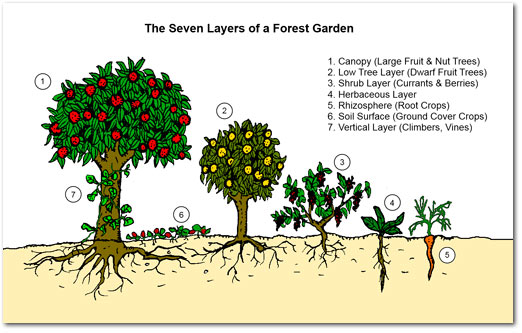
The above graphic is from permaculturenews.org.
A Food Forest, aka permaculture forest garden, is a planted garden or arboretum that mimics a woodland ecosystem but uses plants that produce edible fruits, nuts and vegetables. Fruit and nut trees are the upper level, while below are berry shrubs, and edible perennials and annuals. They are planted together instead of separating the trees into orchards and the berry bushes and vegetables into fields of single-species monocultures. Beneficial plants attract insects for natural pest management and enrich the soil by fixing nitrogen and adding mulch. “Together they create relationships to form a forest garden ecosystem able to produce high yields of food with less maintenance.” Another benefit of this type of gardening is that because of the diversity, it is not a disaster when 1 or 2 crops fail, whether because of weather, pest problems, or other reasons. The challenge, as in any garden landscape, is getting the “right plant in the right place,” with the appropriate amount of sunlight and water.
Historical hunter/gatherer societies depended on nuts, fruits, grains, and vegetables that women gathered. Their diet was supplemented by the meat that hunters brought home (once or twice a week, if they were lucky). With the advent of agriculture, people worked together to grow and preserve the food they needed.
Currently, many Americans are afflicted with diabetes, obesity and other diet-related health problems. We have an abundance of cheap, high-carb foods, with the added fat & sugar we crave along with chemical preservatives and color, flavor and texture enhancers. We are often duped by the latest diet fad or get contradictory information from doctors, nutritionists & the media. Although it is easier to buy packaged food off the grocery store shelf, eating less-processed, natural whole foods will likely be healthier for you and your family. You could even try home canning and preserving.
Nut trees and some fruit trees, however, because of their ultimate size are not well suited for backyard gardens. When I worked at Tacoma’s Wright Park, there were a couple of huge chestnut trees. Chestnuts are gathered by searching amongst the prickly husks that have fallen to the ground. It was often difficult to find nice, big nuts because people and squirrels were both competing for them. One local resident told me he would see people with flashlights searching at 1 or 2 in the morning looking for recently fallen nuts. The Black Walnut tree across the street was also popular with the squirrels. Fruit & nut harvesting could be another enjoyable recreational opportunity at local parks if appropriate tree species were planted. Hunting for and collecting natural foods can be fun for the whole family.
The Beacon Hill neighborhood in Seattle just broke ground on the “Beacon Food Forest” at Jefferson Park. A community urban farming project, it will include a traditional “Pea Patch” along with an Edible Arboretum, Nut Grove & Berry Patch. Neighborhood members will be able to harvest and preserve food for themselves and their families. I wish the Beacon Food Forest success and hope that they are able to equitably divvy up the harvest and will inspire other communities to create their own “Food Forests.”
(This article was first published in the Peninsula Gateway on November 7, 2012)
Mary, Mary, Quite Contrary, How Does Your Garden Grow?
In the1880 U.S. Census, the occupations of 41% of the Heads of Households were listed as Farmer, Farm Laborer or Farming. Of those that had other occupations, you can bet that most of the wives or other members of the family had kitchen gardens and livestock. Growing and preserving food took a lot of time and energy. When my grandparents moved to California in the 1920’s, my grandmother put all her preserves in the back of the car and covered them with a blanket to make a place for my uncles to take their naps. During the depression, she canned 50 quarts of peaches from a tree in the backyard.
In today’s economy, most people purchase the food they eat. Although much of our food is grown in the United States, more and more of it is from other countries. As I attempt to reduce my own carbon footprint, I have been paying more attention to where my food originates. As a Washingtonian, I was dismayed to discover that some packages of dried apple snacks came from China. Isn’t it contrary or even dangerous to our own survival, when we build warehouses on our best farmland, to house imports from other countries?
Across our country, many residents are challenging municipal ordinances that prohibit the raising of farm animals. My mom was a city girl from southern California, but her family always had chickens.
Farming and gardening is labor intensive, but it is worth it if you can grow some of your own fresh, pesticide and preservative-free, animal products, (such as eggs), fruits and vegetables.
If you haven’t started a garden yet this year, you may still be able to buy starts at a nursery or a farmer’s market—or start planning a winter garden. Use a seed catalog to help you plan. Territorial Seeds from Oregon, specialize in varieties that grow in the northwest. When deciding what to grow, you want to grow fruits or vegetables that will yield a crop that is higher in quality and value than what you could buy in the store. High quality vegetable crops would include: asparagus, Brussels sprouts, onions, peas, summer squash, or tomatoes; high value crops would include: broccoli, cucumbers, leaf lettuce, peppers, or rhubarb. Fruits that are easy to grow include: strawberries, blueberries, raspberries, and plums. Raintree Nursery in Morton specializes in fruits that grow in the northwest. –Most importantly you need to grow what your family likes and will eat. As you become more experienced as a gardener, you will learn what grows best for you in your location.
You can preserve your produce by freezing, canning or drying. Most vegetables need to be blanched (plunged in boiling water for a few minutes) before freezing; otherwise enzymes can make them bitter. Canning takes a bit more knowledge, but fruits like peaches and pears are not difficult, and even pickles are fairly easy. For jams and jellies, just follow the recipes on the pectin package. A good book on food preservation will have recipes and important safety tips.
If you do not have the time for your own garden, shop at a farmer’s market to support local growers, or pay attention to where the produce comes from when you shop at your local grocery store. Some farmers are creating co-ops—where customers can pay to have fresh, locally grown produce delivered to their house every week.
Eating locally, sustainably, grown food will help to ensure that we will continue to have access to the sources of energy that sustains our bodies!
(This article was first published in the Peninsula Gateway on Dec 30, 2009 as Value Makes Farming Worthwhile)
Feature Photograph: My raised-bed vegetable garden & cold frame in the background.


